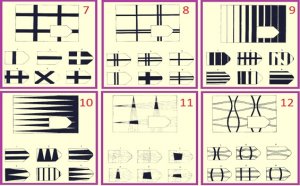Raven's Progressive Matrices: What Are They For?


Written and verified by the psychologist Valeria Sabater
Raven’s Progressive Matrices test is one of the most commonly used instruments to measure analogical reasoning, capacity for abstraction, and perception.
The 60 questions allow us to evaluate the “g” factor of intelligence. This factor was proposed by Spearman, and it’s the more general mental and cognitive processes by which we give answers to everyday problems.
Actually, most of us have taken this test at some point. It’s usually given on a regular basis in schools and in hiring. In fact, it’s now a common part of psycho-technical tests in the selection processes for certain professions.
“Intelligence consists not only of knowledge itself, but also in the skill to apply the knowledge in practice.”
-Aristotle-
Given the contexts we normally take it, we may look at this test with some discomfort. It has been a challenge and determining factor in our academic or professional lives.
However, some people find Raven’s Progressive Matrices very interesting because they enjoy solving those little enigmas. They like solving patterns and series, making inferences, and deciding how to refine perceptions and abstractions…
Be that as it may, one thing is clear. Measuring IQ is still of great interest to many in today’s world. Regardless of whether we accept Howard Gardner’s theory of multiple intelligences, we want to measure and prioritize human capacity for logical reasoning, problem-solving, and critical thinking.
Raven’s Progressive Matrices is an example of the latter. It measures the abstract reasoning and fluid intelligence that Cattell wrote about. It’s the kind of intelligence that allows us to solve most everyday problems. Maybe, in the future, things will change and psycho-technical tests will look different.
Let’s take a look…

What does Raven’s Progressive Matrices do?
J. C. Raven created the Progressive Matrices test in 1938 to measure Spearman’s g. The design of this psychometric test had one objective: to evaluate officers of the U.S. Navy.
However, soon it became apparent that it was useful and valid for evaluating intelligence in general, independently of acquired knowledge.
Benefits of Raven’s Progressive Matrices test versus other tests
- It works for children and adults, regardless if the person has communication or motor problems.
- It is a very economical test to administer.
- In general, it’s interesting and entertaining for most people.
- It requires “Gestalt” attention as well as an analogical reasoning where the person must use exploratory behavior. They must also make comparisons and use multiple sources of information to complete the matrices.
Also, one of the biggest benefits of Raven’s Progressive Matrices test is how quickly it provides valid information about adult or child’s cognitive functioning.
On the other hand, it is important that we point something out. The creator of the test, John Raven, made it clear that no one should use this test by itself to measure intelligence. We should consider other sources of information to make the test much more powerful and the results more solid.

How Raven’s Progressive Matrices test goes
The test consists of 60 multiple choice questions, organized by difficulty. They include, as we already know, a series of abstract and incomplete geometric figures that the person must solve. At first glance, it seems like you’re trying to figure out very confusing, disorganized material.
In general, participants have about 45 minutes to complete the test. Enough time for the child or adult to put into practice what is known as the eductive ability. This process is has the follow as its basis:
- Eductive ability is about finding relationships and correlations in what seems to be disorganized information.
- Also, this type of intellectual ability requires us to make comparisons, deductions, mental representations, and use analogical reasoning and logic principles.
All of this makes up Spearman’s g. Many consider it a valid predictor of intelligence in general.

To conclude, Raven’s Progressive Matrices test is a non-verbal tool with scores that don’t depend on the educational level or experience of the test-taker.
It’s also useful for situations where you want to have prior information about the intelligence “in general” of students or job candidates.
Its ease of application and how quickly you can get results means, whether you like it or not, it will stick around…
Raven’s Progressive Matrices test is one of the most commonly used instruments to measure analogical reasoning, capacity for abstraction, and perception.
The 60 questions allow us to evaluate the “g” factor of intelligence. This factor was proposed by Spearman, and it’s the more general mental and cognitive processes by which we give answers to everyday problems.
Actually, most of us have taken this test at some point. It’s usually given on a regular basis in schools and in hiring. In fact, it’s now a common part of psycho-technical tests in the selection processes for certain professions.
“Intelligence consists not only of knowledge itself, but also in the skill to apply the knowledge in practice.”
-Aristotle-
Given the contexts we normally take it, we may look at this test with some discomfort. It has been a challenge and determining factor in our academic or professional lives.
However, some people find Raven’s Progressive Matrices very interesting because they enjoy solving those little enigmas. They like solving patterns and series, making inferences, and deciding how to refine perceptions and abstractions…
Be that as it may, one thing is clear. Measuring IQ is still of great interest to many in today’s world. Regardless of whether we accept Howard Gardner’s theory of multiple intelligences, we want to measure and prioritize human capacity for logical reasoning, problem-solving, and critical thinking.
Raven’s Progressive Matrices is an example of the latter. It measures the abstract reasoning and fluid intelligence that Cattell wrote about. It’s the kind of intelligence that allows us to solve most everyday problems. Maybe, in the future, things will change and psycho-technical tests will look different.
Let’s take a look…

What does Raven’s Progressive Matrices do?
J. C. Raven created the Progressive Matrices test in 1938 to measure Spearman’s g. The design of this psychometric test had one objective: to evaluate officers of the U.S. Navy.
However, soon it became apparent that it was useful and valid for evaluating intelligence in general, independently of acquired knowledge.
Benefits of Raven’s Progressive Matrices test versus other tests
- It works for children and adults, regardless if the person has communication or motor problems.
- It is a very economical test to administer.
- In general, it’s interesting and entertaining for most people.
- It requires “Gestalt” attention as well as an analogical reasoning where the person must use exploratory behavior. They must also make comparisons and use multiple sources of information to complete the matrices.
Also, one of the biggest benefits of Raven’s Progressive Matrices test is how quickly it provides valid information about adult or child’s cognitive functioning.
On the other hand, it is important that we point something out. The creator of the test, John Raven, made it clear that no one should use this test by itself to measure intelligence. We should consider other sources of information to make the test much more powerful and the results more solid.

How Raven’s Progressive Matrices test goes
The test consists of 60 multiple choice questions, organized by difficulty. They include, as we already know, a series of abstract and incomplete geometric figures that the person must solve. At first glance, it seems like you’re trying to figure out very confusing, disorganized material.
In general, participants have about 45 minutes to complete the test. Enough time for the child or adult to put into practice what is known as the eductive ability. This process is has the follow as its basis:
- Eductive ability is about finding relationships and correlations in what seems to be disorganized information.
- Also, this type of intellectual ability requires us to make comparisons, deductions, mental representations, and use analogical reasoning and logic principles.
All of this makes up Spearman’s g. Many consider it a valid predictor of intelligence in general.

To conclude, Raven’s Progressive Matrices test is a non-verbal tool with scores that don’t depend on the educational level or experience of the test-taker.
It’s also useful for situations where you want to have prior information about the intelligence “in general” of students or job candidates.
Its ease of application and how quickly you can get results means, whether you like it or not, it will stick around…
This text is provided for informational purposes only and does not replace consultation with a professional. If in doubt, consult your specialist.







